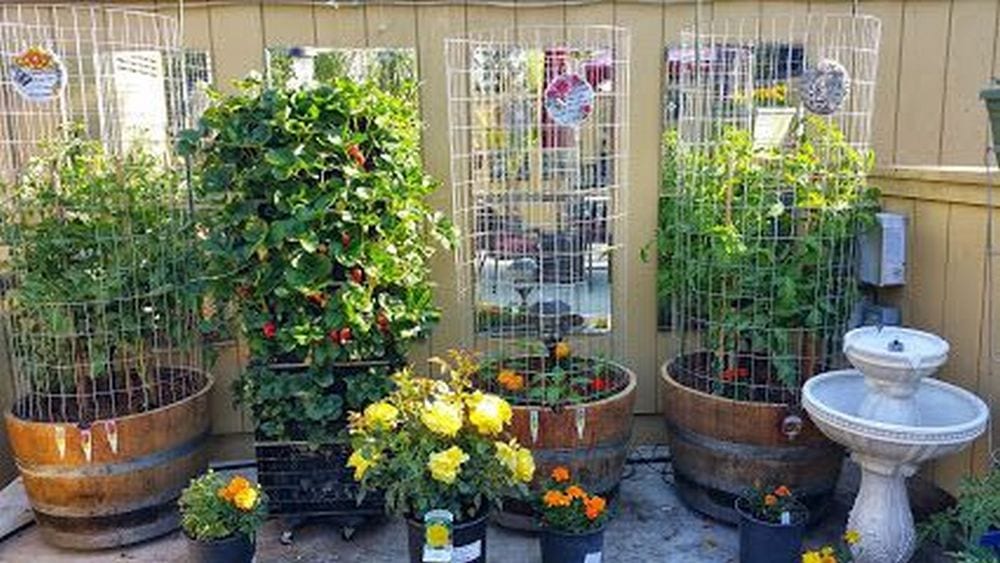
My boys love strawberries. A couple of years ago, we decided to grow our own. The boys enjoyed it so much because it was a family effort. Our first two harvests went well. After that, we had to move the plants because they were infested with aphids.
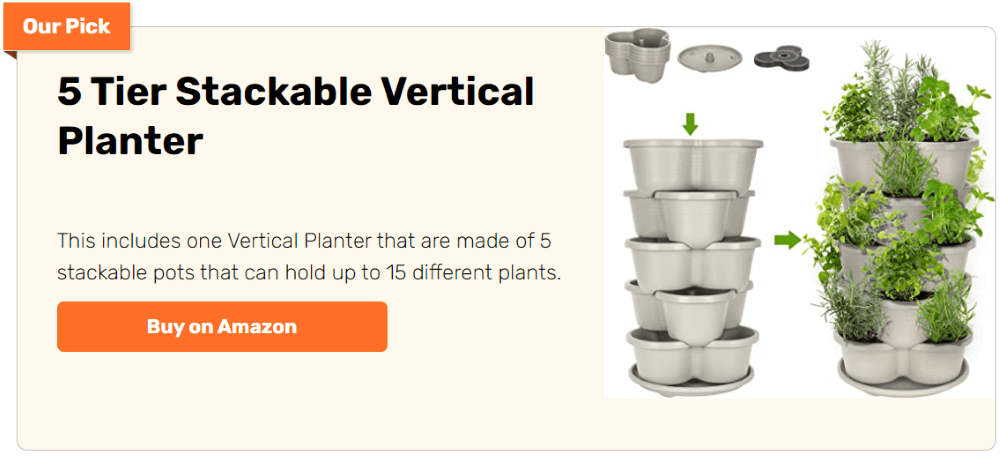
Last year, however, we had an extremely disappointing harvest. We barely noticed that the strawberry plants weren’t getting enough sunshine. They were shaded by a rather tall bush. The plants were just sitting on the ground. Moisture and bugs did a lot of damage.
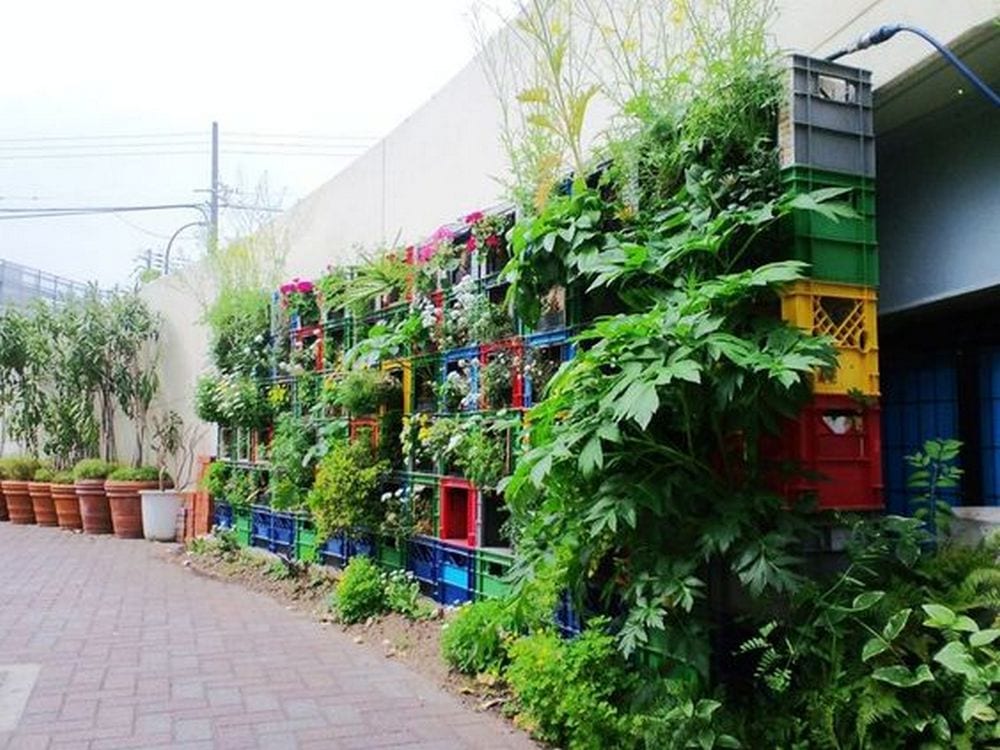
Fortunately, we came across this strawberry milk crate tower. It’s actually a vertical planter which makes planting and harvesting a lot easier. Our strawberry tower now holds healthy plants. We’re looking forward to a bountiful harvest. If you want the same, you might as well start building one now!
Building a Strawberry Milk Crate Tower
Contents
Materials
- Milk crates
- 1 liter plastic water bottle
- Good potting soil
- Compost
- Strawberry seedlings
Tools
- Hole saw
- Drill
Instruction
Step 1: Prepare Your Milk Crates
- Ensure your milk crates are clean and free from any dirt or debris. These crates will serve as the main structure of your tower.
Step 2: Modify the Plastic Bottle for Watering
- Using the drill and hole saw, create small holes along the sides of the 1-liter plastic water bottle. This bottle will act as a slow-release watering system to distribute water evenly throughout the tower.
Step 3: Place the Watering Bottle
- Position the perforated bottle vertically in the center of one milk crate. This setup will be the base of your tower. The bottle should extend slightly above the top edge of the crate for easy refilling.
Step 4: Prepare the Soil Mix
- In a separate container, mix the good potting soil with compost to create a nutrient-rich blend for your strawberries. Ensure the mixture is well combined for the best results.
Step 5: Fill the Crate with Soil
- Begin filling the crate with your soil and compost mixture, surrounding the plastic bottle. Pack the soil firmly to eliminate air pockets but avoid compacting it too tightly, as this could restrict root growth.
Step 6: Plant Your Strawberry Seedlings
- Using the drill and hole saw, create planting holes in the sides of the milk crate. Make sure the holes are evenly spaced to allow room for the strawberry plants to grow.
- Carefully insert strawberry seedlings into each hole, ensuring their roots make good contact with the soil inside the crate. You may also plant strawberries on the top surface of the crate for additional yield.
Step 7: Stack and Repeat
- If you’re building a tower with multiple crates, repeat steps 3 to 6 for each additional crate before stacking them on top of the base crate. Ensure that the watering bottle extends through the center of the stacked crates for easy access.
Step 8: Water Your Tower
- Fill the central watering bottle with water. This will allow water to slowly seep through the holes and moisten the soil evenly, reaching all the plants without overwatering.
Step 9: Position Your Strawberry Tower
- Place your strawberry milk crate tower in a location that receives ample sunlight—at least 6 to 8 hours per day. Ensure the spot is accessible for easy maintenance and harvesting.
Step 10: Maintain Your Tower
- Regularly check the moisture level of the soil and water through the bottle as needed. Keep an eye out for pests and diseases, and remove any dead or diseased foliage promptly. Harvest strawberries when they are fully ripe for the best flavor.
Benefits of Vertical Gardening with Milk Crates
Vertical gardening is a sustainable and efficient way to grow various plants, especially in limited spaces. Using milk crates for this purpose not only recycles these sturdy containers but also provides a flexible, modular approach to gardening. The strawberry milk crate tower is a perfect example of vertical gardening being productive and visually appealing.
Here, we delve into the numerous benefits of adopting vertical gardening with milk crates, focusing on the cultivation of strawberries.
Efficient Use of Space
The primary advantage of a strawberry milk crate tower is its space efficiency. This method allows gardeners to grow strawberries upwards instead of outwards, significantly reducing the footprint required for gardening. It’s ideal for urban settings like balconies, patios, or small backyards with limited ground space. By stacking milk crates, you can create a vertical garden that maximizes your growing area, enabling you to cultivate more strawberries in a confined space.
Enhanced Air Circulation and Sunlight Exposure
Vertical gardens, particularly strawberry milk crate towers, improve air circulation around the plants. This increased airflow helps to reduce the risk of fungal diseases, which strawberries are prone to when grown in traditional gardens. Additionally, vertical gardening ensures that each plant receives ample sunlight, essential for the growth and ripening of strawberries. Better sunlight exposure leads to healthier plants and a more bountiful harvest.
Ease of Maintenance and Harvesting
Maintaining and harvesting strawberries from a milk crate tower is far easier than from a ground-level garden. This setup elevates the plants, making them more accessible and reducing the need for bending or kneeling. This ergonomic advantage is particularly beneficial for gardeners with mobility issues. Furthermore, monitoring for pests, pruning, and harvesting becomes simpler when the plants are at waist or eye level.
Improved Pest and Disease Management
Strawberry milk crate towers elevate the plants off the ground, making it more difficult for pests such as slugs and snails to reach them. This natural barrier significantly reduces the likelihood of pest infestations. Similarly, the improved air circulation and drainage offered by vertical gardening help prevent the onset of soil-borne diseases, keeping your strawberry plants healthier.
Versatility and Mobility
Milk crates are lightweight and portable, allowing gardeners to easily move their strawberry milk crate towers to optimize sunlight exposure or protect the plants from harsh weather conditions. Additionally, the modular nature of milk crate towers offers flexibility in garden design. Gardeners can add or remove crates, experiment with different plant arrangements, and even incorporate other crops alongside strawberries to create a diverse vertical garden.
Aesthetic Appeal
A strawberry milk crate tower is not only functional but also visually appealing. It adds structure and interest to garden spaces, balconies, or patios. With creativity, milk crates can be painted or decorated to enhance their appearance, turning the strawberry tower into a striking feature of your outdoor or indoor living space.
Environmental Benefits
Using milk crates for vertical gardening promotes recycling and reduces waste. Gardeners contribute to a more sustainable and environmentally friendly gardening practice by repurposing these crates as planters. Furthermore, growing strawberries at home can decrease your carbon footprint by reducing the need for store-bought fruits often transported over long distances.
The strawberry milk crate tower exemplifies the many benefits of vertical gardening. It offers a practical, efficient, and aesthetically pleasing solution for growing strawberries, especially in urban environments. Whether a seasoned gardener or a beginner, a milk crate tower is an excellent addition to your gardening endeavors, promising a delightful harvest of fresh strawberries.
Click on any image to start the lightbox display. Use your Esc key to close the lightbox.
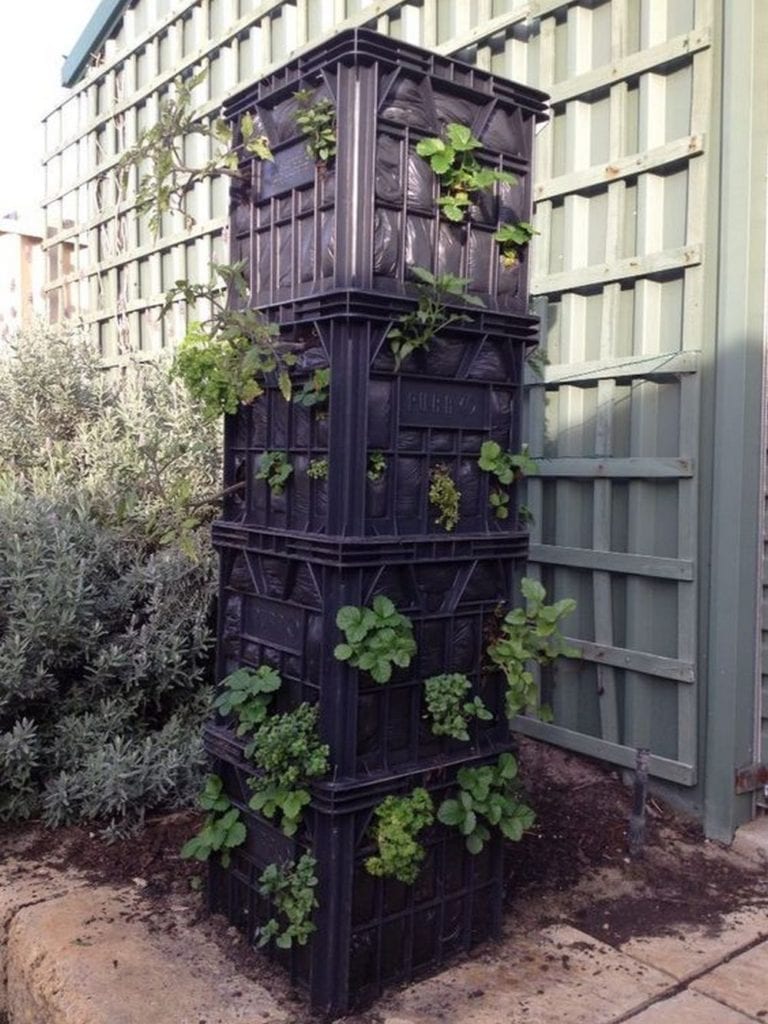

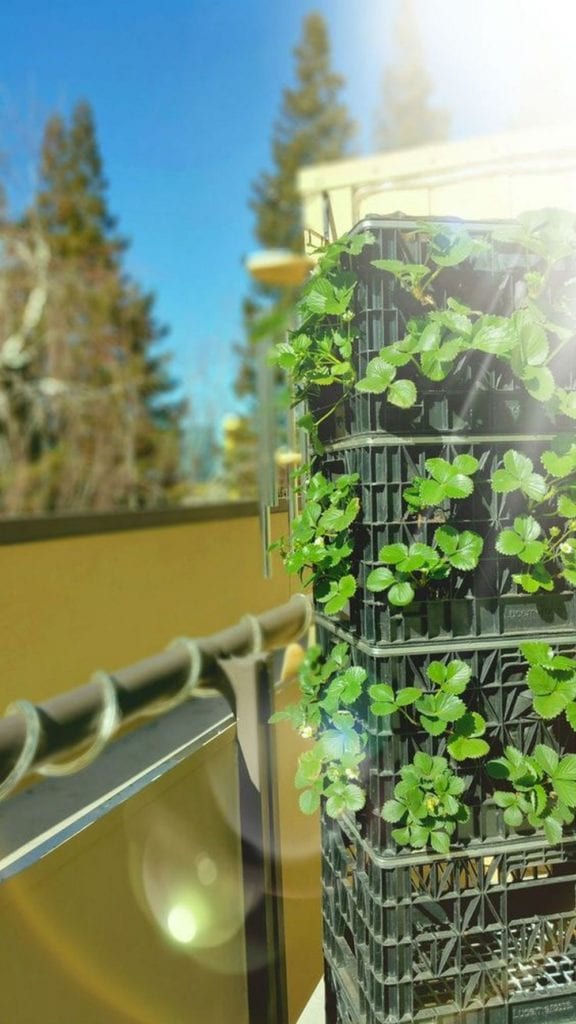

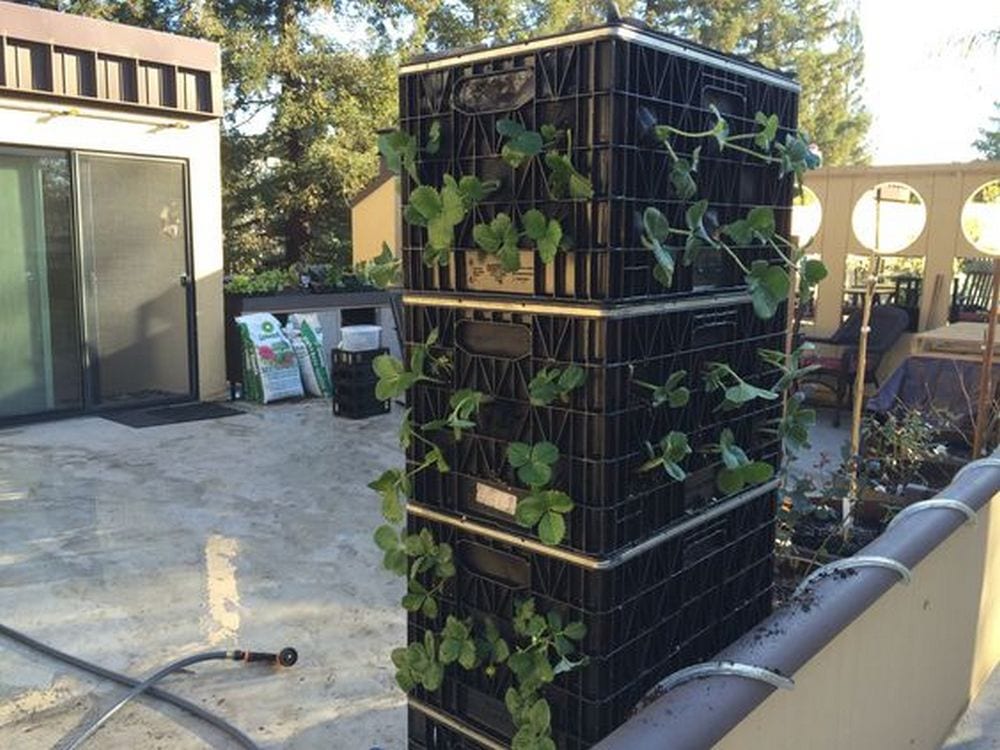

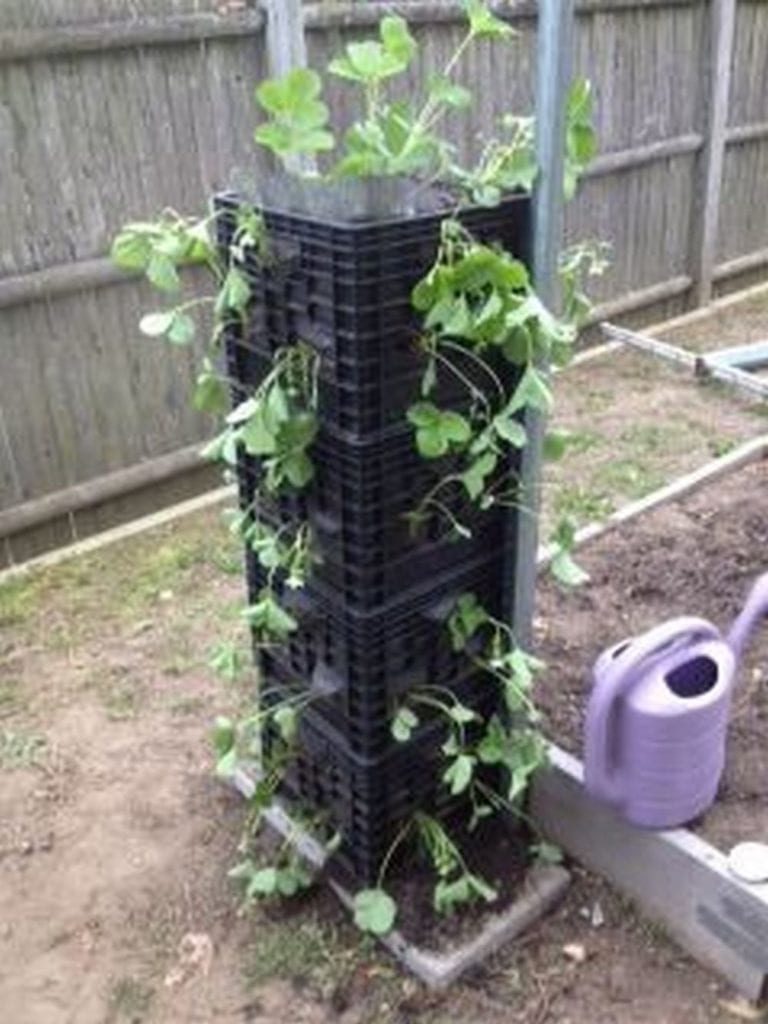
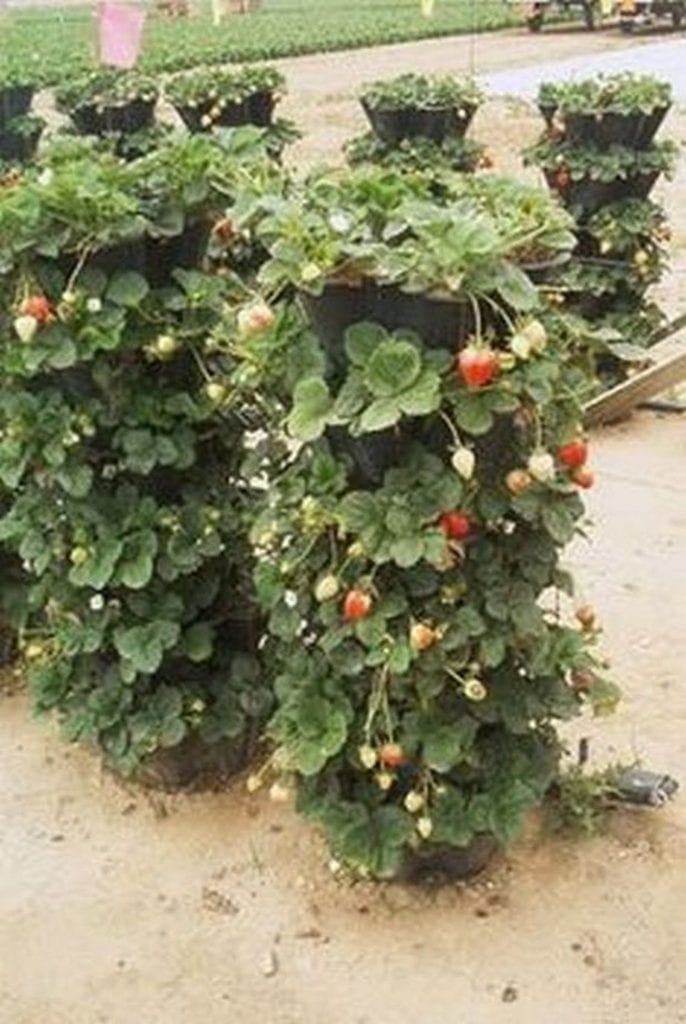

Choosing the Right Location for Your Strawberry Tower
Choosing the ideal location for your strawberry milk crate tower is crucial for ensuring a healthy growth and abundant harvest of strawberries. Strawberries require specific conditions to thrive, and the flexibility of a milk crate tower allows you to take full advantage of your available space to meet these needs.
Here, we’ll guide you through the key factors to consider when selecting the perfect spot for your strawberry tower.
Understanding Strawberry Needs
When planning to set up a strawberry milk crate tower, grasping the fundamental needs of strawberry plants is pivotal. These vibrant and delicious berries flourish under specific conditions essential to yield a bountiful harvest.
Firstly, strawberries demand ample direct sunlight – a minimum of 6 to 8 hours each day. This sunlight is crucial for photosynthesis, aiding in the development of strong, healthy plants and the production of sweet, ripe berries.
Equally important is the quality of the soil. Strawberries thrive in well-drained soil, as stagnant water can lead to root rot and other fungal diseases. The unique design of a strawberry milk crate tower naturally promotes excellent drainage and aeration, mimicking the ideal soil conditions strawberries yearn for.
Additionally, these plants need protection from extreme winds and frost, which can damage the delicate flowers and fruit or kill the plants in severe cases. By understanding these requirements, you can strategically position your strawberry milk crate tower in a spot that not only meets these needs but also enhances the overall growth potential of your strawberry plants.
Assess Sunlight Exposure
The cornerstone of successful strawberry cultivation, especially when employing a strawberry milk crate tower, is ensuring your plants receive sufficient sunlight. The importance of this factor cannot be overstated, as sunlight exposure directly influences the quality and quantity of your strawberry yield.
To find the perfect home for your tower, embark on a day-long survey of your available space. Whether it’s a corner of your garden, a section of your yard, or a spot on your balcony, watch how the sun moves across the area. Look for locations that bask in direct sunlight for most of the day.
This consistent sunlight not only powers the essential processes within the plants but also helps to warm the soil, which strawberries favor. Furthermore, sunlight exposure is key in preventing the growth of mold and mildew, common issues in less sunny, more damp locations. Positioning your strawberry milk crate tower in a spot that maximizes sunlight ensures that each plant within the tower has the energy it needs to grow, bloom, and fruit effectively.
By meticulously assessing potential locations for their sunlight exposure and matching that with the innate needs of strawberry plants, you set the stage for a flourishing strawberry milk crate tower. This proactive approach not only simplifies maintenance but also promises a rewarding harvest of fresh, juicy strawberries, right from the comfort of your home.
Consider Wind and Weather Protection
Selecting a suitable location for your strawberry milk crate tower must include considerations for wind and weather protection. Although strawberries thrive under the sun, they are quite vulnerable to strong winds and adverse weather conditions, hindering their growth and fruit production.
To shield your strawberries, opt for a site that offers natural protection from prevailing winds and severe weather. Placing your strawberry milk crate tower against a sturdy wall or a solid fence serves as a windbreak and ensures that your plants still benefit from adequate air circulation, which is crucial for preventing fungal diseases. This strategic placement can significantly impact the well-being of your strawberry plants, fostering a healthier and more productive garden.
Evaluate Accessibility and Aesthetics
The placement of your strawberry milk crate tower should also prioritize accessibility and aesthetics. Choose a location that allows easy access for regular maintenance tasks such as watering, pruning, and harvesting your ripe strawberries. The convenience of reaching your strawberry tower effortlessly makes the gardening experience more enjoyable and less of a chore.
Furthermore, consider how the strawberry milk crate tower will integrate into the overall design of your garden or balcony. A strategically placed tower can maximize plant health and fruit yield and enhance your space’s visual appeal. With its lush greenery and vibrant red fruits, a well-designed strawberry tower can become an eye-catching centerpiece in your garden or an attractive accent on your balcony. This approach marries functionality with beauty, creating a living art piece that is both productive and pleasing to the eye.
Check for Soil and Water Drainage
Although your strawberry plants will be housed within milk crates, the surrounding environment’s drainage capabilities are still a vital factor to consider. Effective drainage is essential for the health of your strawberries, as waterlogged conditions can lead to root rot, mold, and mildew, all of which are detrimental to your plants.
When scouting for the perfect spot for your strawberry milk crate tower, steer clear of areas prone to water accumulation or where the ground remains soggy after rain. Instead, look for a location with well-draining soil, or consider elevating your tower slightly off the ground to facilitate better water runoff. This precaution ensures that your strawberry plants remain in optimal health, thriving in an environment where moisture levels are well-regulated, and drainage is efficient.
By addressing these key aspects—protection from wind and weather, ease of access, aesthetic considerations, and proper soil and water drainage—you’ll create the ideal conditions for your strawberry milk crate tower to flourish, promising a fruitful and enjoyable gardening venture.
Adaptability and Flexibility
The adaptability and flexibility of a strawberry milk crate tower represent significant benefits, especially in challenging gardening environments. Urban gardeners, in particular, face unique constraints related to space availability and sunlight access. The inherent portability of milk crate towers allows for easy repositioning to optimize growing conditions as the seasons change or as you learn more about the microclimate of your outdoor space.
If, for instance, you discover that the initial placement of your strawberry tower results in insufficient sunlight exposure or exposes the plants to excessive wind, the tower’s design enables quick and hassle-free relocation. This feature is invaluable for ensuring your strawberry plants can thrive, regardless of your garden area’s spatial or environmental limitations.
Embracing the adaptability of the strawberry milk crate tower means you can experiment with different locations until you find the perfect spot. It ensures your strawberries receive the ideal balance of sunlight, shade, and protection from the elements.
Monitor and Adjust
Growing strawberries in a milk crate tower is ongoing and requires attentive care and observation. Once your tower is in place, regularly monitoring the health, growth, and overall well-being of your strawberry plants is crucial. Pay close attention to how the plants adapt to their environment, looking for signs of stress, such as yellowing leaves, stunted growth, or a lack of fruit production. These indicators can suggest that the current location might not be meeting all the plants’ requirements, signaling a need for adjustments.
Healthy, vibrant strawberry plants, bursting with flowers and fruit, are a clear sign that your strawberry milk crate tower is well-positioned. However, gardening is often about trial and error, and even the most experienced gardeners make adjustments to their setups.
Whether moving the tower to capture more sunlight, sheltering it from excessive wind, or altering watering and feeding schedules, responsiveness to the plants’ needs is key. This ongoing commitment to monitoring and adjusting ensures that your strawberry milk crate tower remains a productive and rewarding endeavor, providing you with a bountiful harvest of fresh, home-grown strawberries.
Selecting the right location for your strawberry milk crate tower is a key step towards achieving a successful and enjoyable gardening experience. By carefully considering these factors, you can ensure your strawberries receive the best conditions to thrive and produce a delicious harvest.
Conclusion
Building a strawberry milk crate tower offers an innovative, space-efficient way to grow strawberries, especially in urban environments where ground space is at a premium. This method enhances the aesthetic appeal of any garden or balcony and simplifies maintenance, harvesting, and pest management, leading to healthier plants and bountiful harvests. Embracing the flexibility and adaptability of the strawberry milk crate tower can transform even the smallest spaces into productive and visually appealing gardening ventures.
Read our metal garden beds for more ways to grow strawberries at home!








